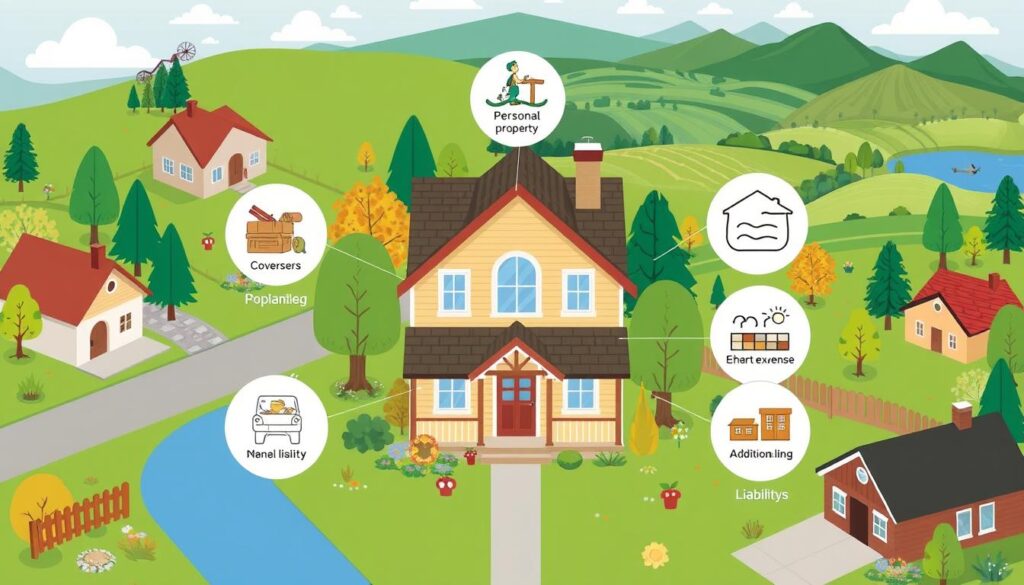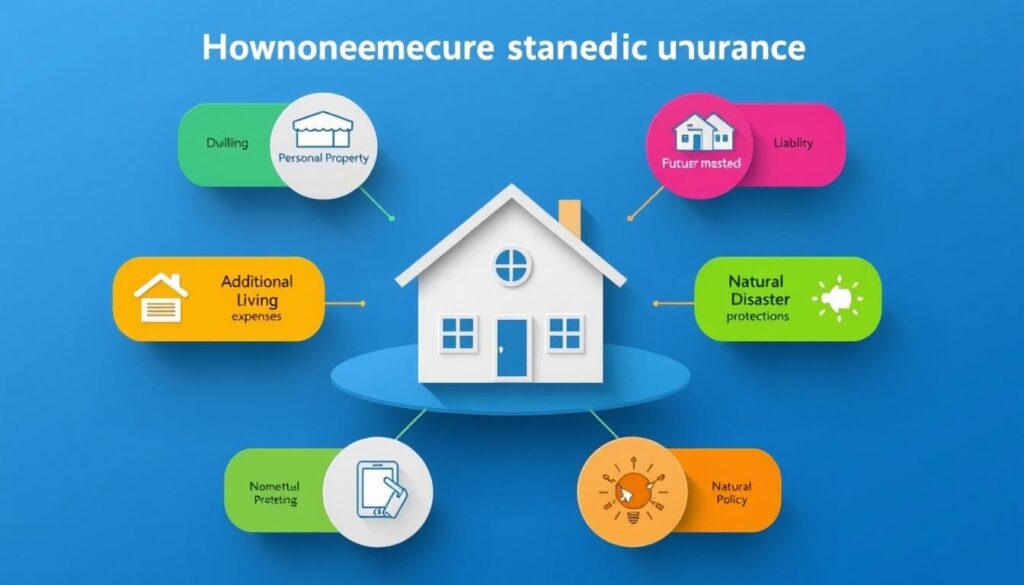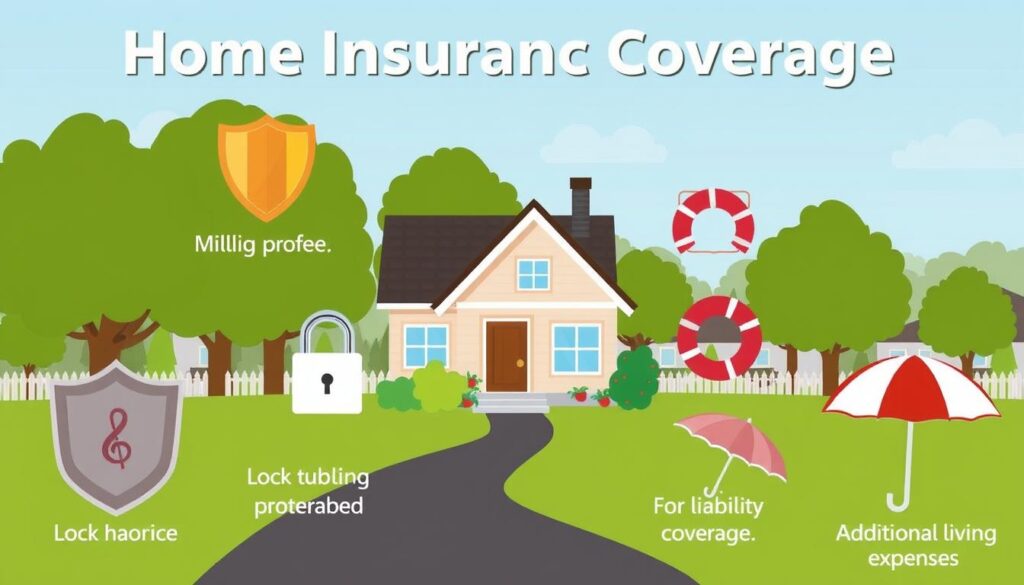In our study, did you ever realize that the homeowners insurance price difference can range up to 50%? This is because every company will have its own formula on how to determine rates. Homeowners should also be aware of the various classes of home insurance. This way, you can really protect your most important asset.
When I looked into the options, I found different types of home insurance. One is made for those who need to be productive on the clock while the other is more general purpose. From basic (HO-1) to more detailed (HO-5), knowing these types helps homeowners make smart choices. This way, they can guard their investments against risks.
A visual representation of various home insurance coverage types, featuring a cozy house surrounded by diverse elements symbolizing different coverage: a shield for dwelling protection, a lock for personal property, a lifebuoy for liability coverage, and an umbrella for additional living expenses, all set against a serene suburban landscape with trees and a clear sky.
Key Takeaways
- Life may take us through different aspects, and to be in a safe side client needs to understand the latest on the home insurance coverage.
- There are eight standard forms of homeowners insurance designed for varied protection needs.
- Premiums for homeowners insurance can differ widely based on coverage options and company policies.
- It’s essential to assess your specific needs and situation when selecting a home insurance policy.
- Some policies may offer additional protections like liability coverage and personal property security.
- Comparing prices and coverage can lead to better value and ensure adequate protection for your home.
Introduction to Home Insurance
Home insurance is key to protecting my home from unexpected damage. It acts as a safety net that lenders often ask for. This way, if disaster strikes, I have money for repairs or new items.
Home insurance covers many things. It usually includes damage to the house, my stuff, and if someone gets hurt on my property. The HO-3 policy, for example, guards against 16 dangers like fire and theft.

A diagram of the coverage options of homeowners insurance showing lovely house in a well designed neighborhood with attractive background, opposite to the house and with relatable objects illustrations of different aspects of homeowners insurance including natural calamities, personal belongings, the clients’ responsibility and extra living costs.
Perhaps, renters might require renters insurance as well. This covers the things inside the rental. It’s usually 50 to 70 percent of the house’s insurance value. Knowing about these options helps me pick the best policy for me.
What is Homeowners Insurance?
It is necessary to comprehend certain peculiarities of the coverage levels. They offer four policy options; actual cash value, replacement cost, and extended replacement cost among others. This assists you in choosing a plan that fits your needs.
The HO-3 policy remains popular in the United States more than other forms of policies. It provides protection for your home and personal property in addition to liability coverage. Among the five classes of policies of homeowners, the HO-5 policies have the broadest form of protection. There are actually eight homeowners insurance policies which come in different policies depending with the need of the client.
Whilst considering the insurance coverage, potential client should take into account the limits offered. Most of these may go up to 50%-70% of the total insured value of your home. You also want to investigate into those policies that indemnify the cost of rebuild that is beyond policy limits. Having this information make it easier for you to get the right homeowners insurance policy.

A visually appealing infographic illustrating various types of homeowners insurance coverage, featuring icons representing dwelling, personal property, liability, additional living expenses, and natural disaster protection, arranged harmoniously around a stylized house in the center, with colorful segments showing the different policy types.
| Policy Type | Coverage Details |
|---|---|
| HO-1 | Basic form covering structure and essential home features. |
| HO-2 | Broad form including home, personal belongings, and some liability. |
| HO-3 | Most common, covering home, personal property, and extensive liability. |
| HO-4 | Renters insurance covering personal belongings and liability. |
| HO-5 | Comprehensive policy covering home and personal property. |
| HO-6 | Condo coverage for unit interiors and liability. |
| HO-7 | Structure and liability protection for RVs and mobile homes. |
| HO-8 | Designed for older homes with unique risks. |
Types of Home Insurance Policies
Knowing about the different types of homeowners insurance is key to making the right choice for my home and stuff. Each policy has its own level of protection, suited for different needs and situations. Let’s look at three main types of home insurance, their special features, and what they cover.
HO-1 Policy: Basic Form
The simplest type of homeowners insurance is the HO-1 coverage. It protects my home’s structure against ten specific dangers like fire and theft. But, it doesn’t cover my personal stuff or if someone gets hurt on my property. Because of this, it’s not sold much anymore.
HO-2 Policy: Broad Form
The HO-2 policy offers more than the basic. It protects my home and stuff against sixteen named dangers. It also covers additional living expenses and responsibility. Even though it’s more comprehensive than HO-1, HO-2 policies are less common than HO-3.
HO-3 Policy: Special Form
Out of all the policies, HO-3 policy is the most purchased one by homeowners. It protects my home’s physical infrastructure against almost any risk of harm, bar floods and earthquake. It also covers my personal belongings against named perils. This policy is a good mix of coverage and cost.
| Home Insurance Type | Coverage for Structure | Coverage for Personal Belongings | Liability Coverage |
|---|---|---|---|
| HO-1 | Yes (limited) | No | No |
| HO-2 | Yes | Yes | Included |
| HO-3 | Yes (open-peril) | Yes (named peril) | Included |
Understanding the different types of home insurance coverage
Looking into the various home insurance plans helps me understand what’s important. Each plan is made for different needs and lifestyles. The HO-4 and HO-5 policies are two main types, each for specific situations.
HO-4 Policy: Renters Insurance
The HO-4 policy, also called renters insurance, is for people who rent. It covers your personal stuff against many dangers. It also includes liability and extra living costs, but it doesn’t cover the building itself.
This makes it a top choice for renters. It keeps your belongings safe, even if you’re not the owner.
HO-5 Policy: Comprehensive Form
The HO-5 policy provides the most comprehensive homeowners insurance coverage. It protects your home and personal items from many risks. It also offers high limits for valuable things.
This policy goes beyond standard insurance. It’s perfect for those who want strong protection for their homes and belongings.
Homeowners Insurance Coverage Options
It’s key to know about homeowners insurance coverage options to protect my home and stuff. Insurance plans can be customized to fit my needs. There are a few main parts to look at when checking these options.
Liability Coverage and Personal Belongings
This means getting coverage for being sued by third parties for injuries they have suffered on my property. He said it pays for mishaps that involves me, for instance, if someone got an injury or if my pet destroyed something. Initial amounts are usually set at $100,000 but it is advised to extend it to $300,000.
It also insures the personal property that I own and are situated inside my home. Sometimes, it extends to property that is carried elsewhere apart from the home. To avoid high risks of theft or damage the customers need to seek additional insurance to cover critical items. Identifying between dwelling coverage and homeowners insurance is very valuable in assisting me get the right insurance policy.
| Coverage Option | Description | Typical Limit |
|---|---|---|
| Liability Coverage | Prevents claims for personal injury and property damage. | $100,000 (recommended minimum $300,000) |
| Personal Belongings Coverage | Covers personal items inside the home, often off-premises included. | Varies based on policy |
| Replacement Cost Coverage | Provides funds to replace damaged items at today’s prices. | Varies based on policy |
| Actual Cash Value Coverage | Value after depreciation, typically lower than replacement cost. | Varies based on policy |
| High-Value Item Coverage | Extra protection for things like jewellery and fine art. | Varies based on item value |
Looking into these options helps make sure my homeowners insurance covers the right risks. Understanding these options helps me make smart choices for my property insurance.
Dwelling Coverage vs Homeowners Insurance
Too often when considering home insurance people confusing dwelling coverage and homeowners insurance. While, building, or contents coverage guarantees the home’s structures or the house, garages and built-in appliances. This goes to compensate for repair or reinvestment in the event of any damages resultant from a given event or occurrence.
Some of the events that are covered include fire, lightning and hail as well as vandalism or car damage. But, it does not protect the property damage due to negligence, water or any natural calamity.
Homeowners insurance however provides more than just the dwelling coverage. : It also includes other areas of personal property, liability and other expenses that you incur when you have to live elsewhere. The understanding of the differences make one decide on what policy to take.
It is important for homeowners to understand that dwelling coverage is actually a large component of homeowners insurance. It is something which works well and meets the specific needs of the person using it. You can also control your coverage to cater for your home and the belongings inside it very well. Getting an extra for floods or earthquakes is safe to have.
To determine amount that you require of dwelling coverage, it is necessary to refer to the size of the house and cost of reconstructing in respective region. In this way it will be possible to provide your home sufficient protection against various fortuitous occurrences.
Comparing Home Insurance Coverage
Choosing the right home insurance policy is crucial. Finding the best solution for me requires comparing several options. By understanding what each policy offers, I can make sure my home and belongings are well-protected.
How to Assess Your Needs
Before making a decision, it’s key to know what I need. Here are some important factors to consider:
- Home Value: Knowing my home’s current market value is essential for the right protection.
- Personal Belongings: I need to value my possessions to ensure the policy covers them adequately.
- Liability Risk: Assessing my potential liability helps in choosing the right coverage limits.
By carefully assessing my needs, I can pick a policy that protects me financially. This way, I avoid being underinsured.
Understanding Home Insurance Terminology
Knowing the terms used in home insurance policies is vital. Understanding these terms helps me grasp what each policy offers:
| Term | Description |
|---|---|
| Deductible | The amount I must pay out-of-pocket before insurance kicks in. |
| Premium | The amount I pay for the insurance policy, usually on an annual or monthly basis. |
| Exclusions | Conditions or perils that are not covered under the policy. |
| Endorsements | Additional coverages or modifications that can be added to the standard policy. |
| Replacement Cost Value | Covers replacement of damaged items at current prices without depreciation. |
| Actual Cash Value | Considers depreciation when calculating the payout for damaged items. |
Understanding these terms helps me make better choices. Every year, I should examine my policy as well. What coverage I require may change if my life or property changes.
Choosing the Right Home Insurance Policy
Choosing the right home insurance policy is a big decision. It’s important to consider many factors. I find that looking at different coverage levels helps me make a choice that fits my needs.
Evaluating Different Coverage Levels
When I look at coverage levels, I carefully review each policy. I want to know what can be attained and what cannot be attained. For instance, the Special Form Policy (HO-3) pertains to all perils with the exception of floods and earth-quakes.
- Dwelling Coverage: This protects my home from damage. It important to understand what is offered say in the HO-3 type of the insurance.
- Personal Belongings Coverage: This covers my personal items, usually 50% to 70% of my home’s value. It’s important to check if it covers my valuable items.
- Liability Protection: This protects me from claims for injuries or damages on my property.
Home Protection Plans and Add-ons
I also look at home protection plans and add-ons. These can make my policy better, like:
- Flood and Earthquake Coverage: These are often not included in standard policies. Adding them is crucial if I live in a flood or earthquake zone.
- High-Value Property Coverage: For things like jewelry or artwork, I might need extra coverage.
- Umbrella Liability Policies: These provide extra protection beyond what my standard policy offers.
| Policy Type | Coverage Scope |
|---|---|
| HO-1 Basic Form | Specific perils, limited coverage. |
| HO-3 Special Form | Covers all risks except specific exclusions. |
| HO-5 Comprehensive Form | Highest coverage level with broader risk protection. |
| HO-4 Tenants Policy | Covers personal property and liability. |
| HO-6 Condo Insurance | Coverage for unit contents and property alterations. |
By considering all these factors, I feel more confident in my choice. Understanding coverage levels and available plans helps me protect my home well.
Conclusion
Understanding home insurance types is key for homeowners or those looking to buy a home. The HO-3 policy is common and protects single-family homes well. The HO-5 offers more coverage, especially for personal items.
Renters and condo owners have separate insurance types, such as HO-4 and HO-6. These meet the unique needs of different living situations.
Choosing the right home insurance involves considering my specific risks. This includes where I live and my home’s features. Many policies don’t cover risks like flood damage, so I might need extra insurance.
I also know that higher coverage and lower deductibles can raise my premiums. So, I try to find a balance between cost and protection.
It’s important to review and update my insurance policy often. This keeps me well-protected as my life changes. Knowing about home insurance helps me protect my property wisely. It’s a smart investment for the future.
FAQ
What is home insurance and why do you need it?
Household insurance protects your home and its contents from natural disasters. It also pays if a person gets injured in your home or on your property. It is usually necessary for most lenders to secure your investment.
What are the common types of homeowners insurance policies?
There are eight main types of homeowners insurance. HO-3 is the most common. You own for your house, comprehensive coverage and for your things or assets, incomplete coverage.
How can I find out what personality of home insurance is best for me?
Consider your home’s worth, what you possess, and whether you’re suit risk. Check various policies to get the one that is right for you.
What is dwelling coverage and how does it differ to homeowners insurance?
Dwelling coverage insulates the actual structure of the home or house you live in against natural occurrences. This one also protects the belongings in the home, the owner from any legal liability, and their living costs, too. This is very relevant today because knowing the difference between the two helps you get the right coverage.
Do renters really need renters insurance, and what does it include?
Indeed, renters insurance is essential. It also shields your belongings from theft and even from being damaged. It also includes reimbursement for the period someone is suing you. But what it lacks is coverage of the building itself.
What kind of things should I compare between the various home insurance policies?
Check out the coverage, limits of the policy, and what is excluded. Also for this reason, consider extra features like flood or earthquake insurance. This makes sure that, you are given all the cover that you need.
Are there ways to save on my home insurance?
Reduce coverage in order to have cheap home insurance, Buy a policy that requires you to pay more out of pocket and enroll for multiple policies. Other factors includes having a good credit score and install home safety equipments. These actually reduce your premiums of car insurance.



